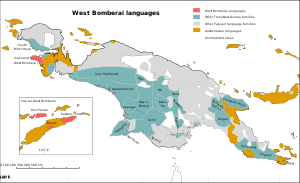West Bomberai languages
The West Bomberai languages are a family of Papuan languages spoken on the Bomberai Peninsula of western New Guinea and in East Timor and neighboring islands of Indonesia.
| West Bomberai | |
|---|---|
| Bomberai–Timor | |
| Geographic distribution | West New Guinea, East Timor |
| Linguistic classification | Trans–New Guinea
|
| Subdivisions | |
| Glottolog | west2604 (mainland West Bomberai)[1] timo1261 (Timor–Alor–Pantar)[2] |
 Map: The West Bomberai languages of New Guinea
The West Bomberai languages
Other Trans–New Guinea languages
Other Papuan languages
Austronesian languages
Uninhabited | |
Languages
Two of the languages of the mainland, Baham and Iha, are closely related to each other; the third is distant, forming a third branch of the family along with the Timor–Alor–Pantar languages:[3]
- Mbahaam–Iha: Baham (Mbaham), Iha
- Karas
- Timor–Alor–Pantar
Ross (2005) classified Timor–Alor–Pantar with the mainland West Bomberai languages, although this connection is not universally accepted. Usher found that the Timor–Alor–Pantar languages resides within the West Bomberai languages, and is not just their closest relative. This suggests that Timor–Alor–Pantar may have been the result of a relatively recent migration from New Guinea, perhaps arriving in the Timor area shortly before the Austronesian languages did.
Classification
Ross (2005) classifies Timor–Alor–Pantar with the West Bomberai languages, the two groups forming a branch within West Trans–New Guinea. Based on a careful examination of new lexical data, Holton & Robinson (2014) find little evidence to support a connection between TAP and TNG.[4] However, Holton & Robinson (2017) concedes that a relationship with Trans-New Guinea and West Bomberai in particular is the most likely hypothesis, though they prefer to leave it unclassified for now.[5] Usher (2020) finds that the two mainland branches of the family are no closer to each other than they are to the Timor–Alor–Pantar languages, and has begun to reconstruct the West Bomberai protolanguage.[3]
Phonemes
Usher (2020) reconstructs the consonant and vowel inventories as:[3]
*p *t [*ts] *k *kʷ *mb *nd [*ndz] *ŋg *ŋgʷ *m *n *s *w *l, *r *j
Prenasalized plosives do not occur initially, having merged with the voiceless plosives.
The vowels are *i *u *e *o *a *ɒ and the diphthong *ai.
Pronouns
Usher (2020) reconstructs the free pronouns as:[3]
sg pl 1excl *[a/o]n *in 1incl *pi (?) 2 *k[a/o] *ki
Cognates
Protoforms of the 40 most-stable items[6] in the Swadesh list include the following.[3]
gloss Proto–West Bomberai *am[i/u]n louse *kira water *kʷali ear *k[i/u]m[i/u] die *[a/o]n I *kina eye *tana hand/arm *nai name *war stone *ami breast *k[a/o] you *[ja]ŋgal path ? tongue (*maŋg[a] voice/speech) *aŋgin body/skin *kaja rain *waik blood *ukʷan[i] one *ma come *tVmber mountain *ni- we *na[wa] eat/drink *kena[t] see *kʷel[e] skin/bark *jambar dog
References
- Hammarström, Harald; Forkel, Robert; Haspelmath, Martin, eds. (2017). "West Bomberai". Glottolog 3.0. Jena, Germany: Max Planck Institute for the Science of Human History.
- Hammarström, Harald; Forkel, Robert; Haspelmath, Martin, eds. (2017). "Timor–Alor–Pantar". Glottolog 3.0. Jena, Germany: Max Planck Institute for the Science of Human History.
- New Guinea World, West Bomberai
- Holton, Gary; Robinson, Laura C. (2014), "The linguistic position of the Timor-Alor-Pantar languages", in Klamer, Marian (ed.), Alor Pantar languages: History and Typology, Berlin: Language Sciences Press, pp. 155–198, doi:10.17169/langsci.b22.48
- Holton, Gary; Robinson, Laura C. (2017), "The linguistic position of the Timor-Alor-Pantar languages", in Klamer, Marian (ed.), Alor Pantar languages: History and Typology Second Edition, Berlin: Language Sciences Press, pp. 147–190, doi:10.5281/zenodo.437098
- Holman, Eric W., Søren Wichmann, Cecil H. Brown, Viveka Velupillai, André Müller, Dik Bakker (2008). "Explorations in Automated Language Classification". Folia Linguistica, Vol. 42, no. 2, 331–354
External links
- Timothy Usher, New Guinea World, Proto–West Bomberai